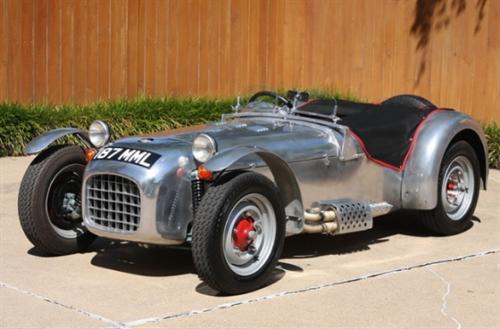
The Mark 6 is recognised as the first volume-built model from Lotus founder Colin Chapman. Everything prior to this had been single cars. Based on his own design of spaceframe chassis, and with him now working full-time at his fledgling business, this is the point at which Lotus became a proper car manufacturer.
Bearing the registration XML 6, the first Mark 6 came with boxy aluminium bodywork and initially had fully enclosed rear wheel arches, though these were soon cut away. In its first competition, at Silverstone circuit on 5 July 1952, it scored two 2nd places. Another version of the Mark 6 with a more powerful engine was driven and reviewed by Autocar magazine and hit a top speed of almost 90mph.
Available as a road and race car, the buyer would usually source their own engine and take it to Chapman for his band of enthusiastic volunteers to modify and fit to the chassis. A completed car would cost around £400, which was excellent value at the time.
Chapman was joined by fellow competitors Peter Gammon and Mike Anthony in racing versions of the Mark 6. They were dominant for two years before production of the car ended in 1955.
In 1957, while Lotus was building the more advanced Lotus Eleven road car and Lotus 12 race car, a spiritual successor to the Mark 6 was launched. Called the Mark 7, it was cheaper in price and aimed at the hobbyist driver. Although not built in large numbers during its 17 years of Lotus production, the design was sold to Caterham Cars and famously continues to be built to this day.

| NAME | Lotus Mark 6 |
| YEAR OF PRODUCTION | 1952-55 |
| VOLUME | 110 |
| ENGINE | Ford Consul sidevalve |
| POWER OUTPUT | 45 bhp |
| TRANSMISSION | Ford three-speed |
| WEIGHT | 431 kg |

The Mark 8 is a strikingly different-looking Lotus car compared with what had come before, though the idea of a more streamlined exterior to reduce drag and therefore improve top speed was the final part of its development. The principle objective was to create a car around the most minimal triangulated chassis frame possible, with a strong focus on cutting overall weight.
The design was created by Frank Costin, an aerodynamicist at the de Havilland Aircraft Company. Lotus founder Chapman famously said he didn’t really like the way the car looked, but accepted the speed advantages which came with such a smooth shape.
The Mark 8 made its racing debut on 10 April 1954 at Oulton Park circuit, having been involved in a minor crash on the way to the event. This race meeting has gone down in company history as the public debut of the ‘Team Lotus’ name which later became so success on the world motorsport stage.
The Mark 8’s season highpoint was at Silverstone on 17 July at the British Grand Prix meeting, with Chapman himself beating a works team Porsche to win one of the support races. Drivers John Coombs and Nigel Allen were each driving a Mark 8 while Peter Gammon and Mike Anthony were in a Mark 6. Overall performances by Team Lotus meant it won the team award on the day.
| NAME | Lotus Mark 8 |
| YEAR OF PRODUCTION | 1954 |
| VOLUME | 7 |
| ENGINE | MG / Morris |
| POWER OUTPUT | 85 bhp |
| TRANSMISSION | MG four-speed |
| WEIGHT | 520 kg |

You must be logged in to post a comment.